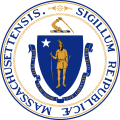| Elections in Massachusetts |
|---|
 |
Massachusetts held its elections November 7, 1814. State law required a majority vote for election, which was not met in two districts, leading to a second election January 6, 1815.
Contents
| District [a] | Incumbent | This race | |||
|---|---|---|---|---|---|
| Representative | Party | First elected | Results | Candidates | |
| Massachusetts 1 "Suffolk district" | Artemas Ward Jr. | Federalist | 1812 | Incumbent re-elected. [1] | √ Artemas Ward Jr. (Federalist) 96.9% Benjamin Austin (Democratic-Republican) 3.1% |
| Massachusetts 2 "Essex South district" | Timothy Pickering Redistricted from the 3rd district | Federalist | 1812 | Incumbent re-elected. | √ Timothy Pickering (Federalist) 89.2% Daniel Kilham (Democratic-Republican) 10.8% |
| Massachusetts 3 "Essex North district" | William Reed Redistricted from the 2nd district | Federalist | 1810 | Incumbent retired. New member elected. Federalist hold. Successor either declined the seat or resigned after the term began, leading to a special election. | √ Daniel A. White (Federalist) 89.6% Thomas Kitteridge (Democratic-Republican) 10.2% |
| Massachusetts 4 "Middlesex district" | Samuel Dana | Democratic-Republican | 1814 (Special) | Incumbent lost re-election. New member elected. Federalist gain. | √ Asahel Stearns (Federalist) 53.5% Samuel Dana (Democratic-Republican) 46.5% |
| Massachusetts 5 "Hampshire South district" | William Ely | Federalist | 1804 | Incumbent retired. New member elected. Federalist hold. | √ Elijah H. Mills (Federalist) 89.4% Enos Foot (Democratic-Republican) 10.6% |
| Massachusetts 6 "Hampshire North district" | Samuel Taggart | Federalist | 1803 | Incumbent re-elected. | √ Samuel Taggart (Federalist) 61.7% Samuel C. Allen (Federalist) 30.2% Solomon Snead (Democratic-Republican) 8.2% |
| Massachusetts 7 "Berkshire district" | John W. Hulbert Redistricted from the 12th district | Federalist | 1812 | Incumbent re-elected. | √ John W. Hulbert (Federalist) 55.6% William P. Walker (Democratic-Republican) 44.4% |
| Massachusetts 8 "Plymouth district" | William Baylies Redistricted from the 7th district | Federalist | 1812 | Incumbent re-elected. | √ William Baylies (Federalist) 65.3% Seth Sprague (Democratic-Republican) 33.5% Joseph Rice (Democratic-Republican) 1.2% |
| Massachusetts 9 "Barnstable district" | John Reed Jr. Redistricted from the 8th district | Federalist | 1812 | Incumbent re-elected. | √ John Reed Jr. (Federalist) 78.4% Thomas Hazard Jr. (Democratic-Republican) 19.5% Joseph Dimmick (Democratic-Republican) 2.1% |
| Massachusetts 10 "Bristol district" | Laban Wheaton Redistricted from the 9th district | Federalist | 1808 | Incumbent re-elected. | √ Laban Wheaton (Federalist) 65.2% Marcus Morton (Democratic-Republican) 34.8% |
| Massachusetts 11 "Worcester South district" | Elijah Brigham Redistricted from the 10th district | Federalist | 1810 | Incumbent re-elected. | √ Elijah Brigham (Federalist) 66.2% John Spurr (Democratic-Republican) 33.8% |
| Massachusetts 12 "Worcester North district" | Abijah Bigelow Redistricted from the 11th district | Federalist | 1810 | Incumbent retired. New member elected. Federalist hold. | √ Solomon Strong (Federalist) 74.8% Edmund Cushing (Democratic-Republican) 25.2% |
| Massachusetts 13 "Norfolk district" | Nathaniel Ruggles | Federalist | 1812 | Incumbent re-elected. | √ Nathaniel Ruggles (Federalist) 57.4% Thomas Boylston Adams (Democratic-Republican) 42.6% |
| Massachusetts 14 "1st Eastern district", District of Maine | Cyrus King | Federalist | 1812 | Incumbent re-elected. | √ Cyrus King (Federalist) 53.1% John Holmes (Democratic-Republican) 46.9% |
| Massachusetts 15 "2nd Eastern district", District of Maine | George Bradbury | Federalist | 1812 | Incumbent re-elected. | √ George Bradbury (Federalist) 64.7% Ezekiel Whitman (Democratic-Republican) |
| Massachusetts 16 "3rd Eastern district", District of Maine | Abiel Wood Redistricted from the 17th district | Democratic-Republican | 1812 | Incumbent lost re-election. New member elected. Federalist gain. | √ Benjamin Brown (Federalist) 61.7% Abiel Wood (Democratic-Republican) 38.3% |
| Massachusetts 17 "4th Eastern district", District of Maine | John Wilson Redistricted from the 18th district | Federalist | 1812 | Incumbent lost re-election. New member elected. Democratic-Republican gain. | First ballot (November 7, 1814): John Wilson (Federalist) 49.3% James Carr (Federalist) 48.3% Others 2.4% Second ballot (January 6, 1815): √ James Carr (Federalist) 57.0% John Wilson (Federalist) 43.0% |
| Massachusetts 18 "5th Eastern district", District of Maine | James Parker Redistricted from the 19th district | Democratic-Republican | 1813 | Incumbent lost re-election. New member elected. Federalist gain. | √ Thomas Rice (Federalist) 56.4% James Parker (Democratic-Republican) 43.6% |
| Massachusetts 19 "6th Eastern district", District of Maine | Samuel Davis Redistricted from the 16th district | Federalist | 1812 | Incumbent lost re-election. New member elected. Democratic-Republican gain. | First ballot (November 7, 1814): Samuel S. Conner (Democratic-Republican) 49.3% Timothy Boutelle (Federalist) 48.8% William Reed (Democratic-Republican) 1.5% Others 0.4% Second ballot (January 6, 1815): √ Samuel S. Conner (Democratic-Republican) 52.4% Timothy Boutelle (Federalist) 47.6% |
| Massachusetts 20 "7th Eastern district", District of Maine | Levi Hubbard | Democratic-Republican | 1812 | Incumbent retired. New member elected. Democratic-Republican hold. | √ Albion K. Parris (Democratic-Republican) 56.6% Samuel A. Bradley (Federalist) 43.4% |